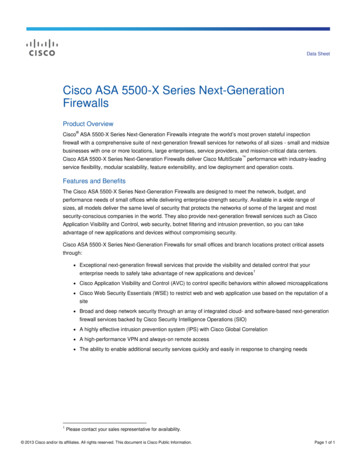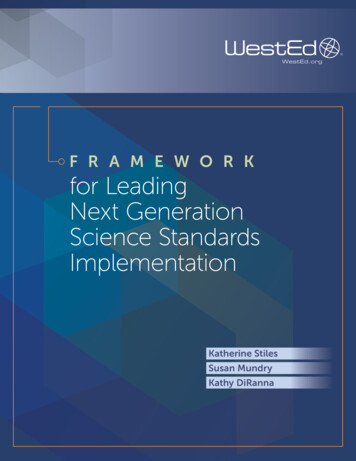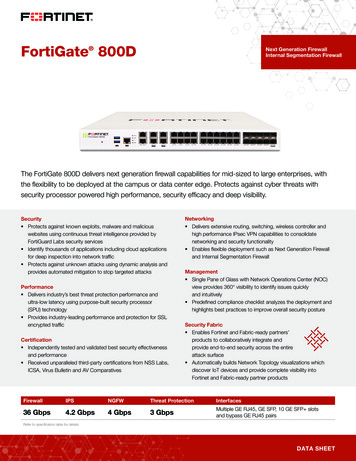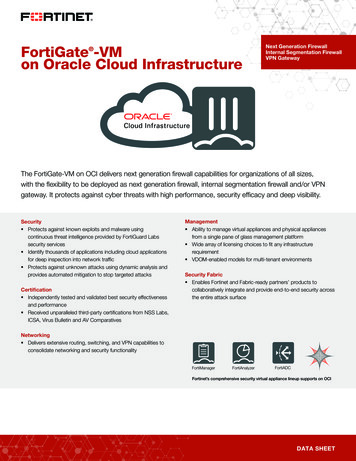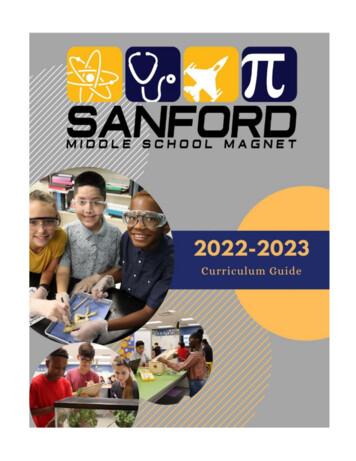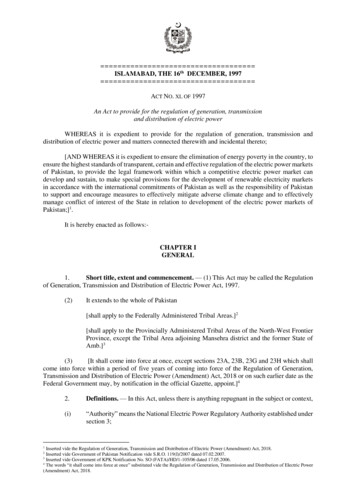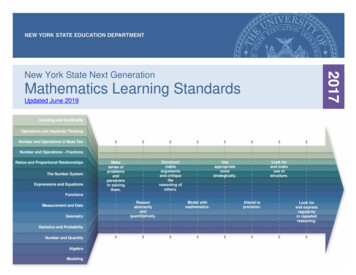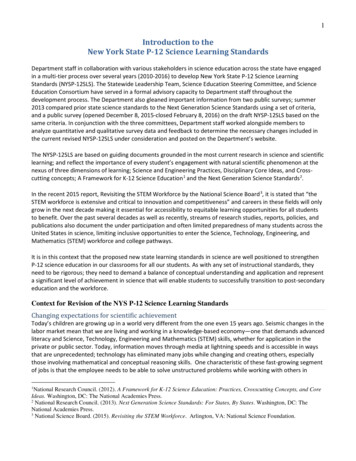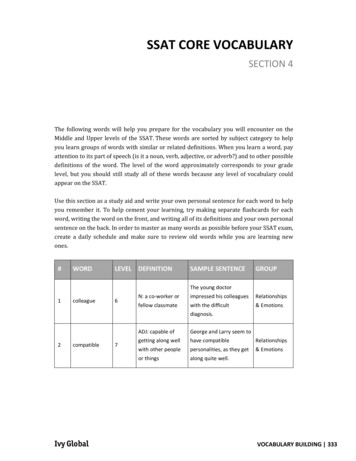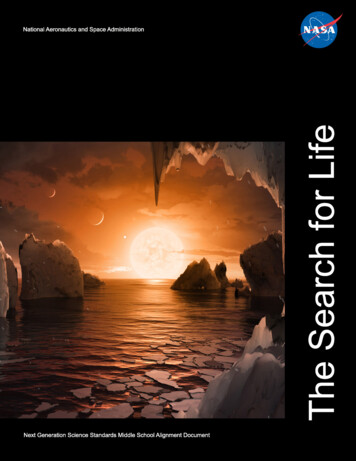
Transcription
The Search for LifeNational Aeronautics and Space AdministrationNext Generation Science Standards Middle School Alignment Document
National Aeronautics and Space AdministrationThe Search for LifeMiddle School Next Generation Science Standards Alignment DocumentWHAT STUDENTS DO: Explore the key moments in Earth’s biogeological history.Students travel back in geologic time to explore some of the major historical events ofEarth in an attempt to understand the search for life on other planets in the universe.NRC FRAMEWORK/NGSS CORE & COMPONENT QUESTIONSWHAT IS THE UNIVERSE AND WHAT IS EARTH’SPLACE IN IT?INSTRUCTIONAL OBJECTIVES (IO)Students will be able toNGSS Core Question: ESS1: Earth’s Place in the UniverseIO1: Construct an argumentHow do people reconstruct and date events in Earth’splanetary history?NGSS ESS1.C: The History of Planet EarthHOW CAN THERE BE SO MANY SIMILARITIESAMONG ORGANISMS YET SO MANY DIFFERENTKINDS OF PLANTS, ANIMALS, ANDMICROORGANISMS?about the constraintsand limitationsregarding the searchfor life in the universeusing evidence fromEarth’s rock record.NGSS Core Question: LS4: Biological Evolution: Unity and DiversityWhat evidence shows different species are related?NGSS LS4.A: Evidence of Common Ancestry and DiversityThis material is based upon work supported by NASA under cooperative agreement No. NNX16AD79A. Any opinions, findings, andconclusions or recommendations expressed in this material are those of the author(s) and do not necessarily reflect the views of theNational Aeronautics and Space Administration. This lesson was prepared by Arizona State University’s Education ThrougheXploration (ETX) Center. Lesson formatting was adopted and adapted from Arizona State University’s Mars Education Program.The lesson and its’ associated materials may be photocopied and distributed freely for non-commercial purposes. Copyright 20162021.Last edited: November 1, 2018
National Aeronautics and Space Administration1.0 About This ActivityHow Students Learn: Science in the Classroom (Donovan & Bransford, 2005) advocates theuse of a research-based instructional model for improving students’ grasp of central scienceconcepts. Based on conceptual-change theory in science education, the 5E Instructional Model(BSCS, 2006) includes five steps for teaching and learning: Engage, Explore, Explain,Elaborate, and Evaluate. The Engage stage is used like a traditional warm-up to pique studentcuriosity, interest, and other motivation-related behaviors and to assess students’ priorknowledge. The Explore step allows students to deepen their understanding and challengesexisting preconceptions and misconceptions, offering alternative explanations that help themform new schemata. In Explain, students communicate what they have learned, illustrating initialconceptual change. The Elaborate phase gives students the opportunity to apply their newfoundknowledge to novel situations and supports the reinforcement of new schemata or its transfer.Finally, the Evaluate stage serves as a time for students’ own formative assessment, as well asfor educators’ diagnosis of areas of confusion and differentiation of further instruction. The 5Estages can be cyclical and iterative.This material is based upon work supported by NASA under cooperative agreement No. NNX16AD79A. Any opinions, findings, andconclusions or recommendations expressed in this material are those of the author(s) and do not necessarily reflect the views of theNational Aeronautics and Space Administration. This lesson was prepared by Arizona State University’s Education ThrougheXploration (ETX) Center. Lesson formatting was adopted and adapted from Arizona State University’s Mars Education Program.The lesson and its’ associated materials may be photocopied and distributed freely for non-commercial purposes. Copyright 20162021.Last edited: November 1, 2018
National Aeronautics and Space Administration2.0 Instructional Objectives, Learning Outcomes, Standards, & RubricsVisit https://infiniscope.org/lesson/stories-in-rock/ for access to the digital learning experience,lesson plans, standards alignment documents, and additional resources.Instructional objectives and learning outcomes are aligned with Achieve Inc.’s, Next Generation Science Standards (NGSS) National Research Council’s, A Framework for K-12 Science Education: Practices,Crosscutting Concepts, and Core Ideas National Governors Association Center for Best Practices (NGA Center) and Council ofChief State School Officers (CCSSO)’s, Common Core State Standards for EnglishLanguage Arts & Literacy in History/Social Studies, Science, and Technical SubjectsThe following chart provides details on alignment among the core and component NGSSquestions, instructional objectives, learning outcomes, and educational standards. Your instructional objectives (IO) for this lesson align with the NRC Framework andNGSS. You will know that you have achieved these instructional objectives if studentsdemonstrate the related learning outcomes (LO), also aligned with the NRCFramework and NGSS. You will know the level to which your students have achieved the learning outcomes byusing the suggested rubrics.Important Note: This lesson is color-coded to help teachers identify each of the threedimensions of NGSS. The following identifying colors are used: Practices are blue,Cross-Cutting Concepts are green, and Disciplinary Core Ideas are orange.This color-coding is consistent with the NGSS Performance Expectations andFoundation Boxes.Quick View of Standards Alignment:This alignment document provides full details of the way in which instructional objectives,learning outcomes, 5E activity procedures, and rubric assessments were derived through, andalign with the Next Generation Science Standards (NGSS). For convenience, a quick viewfollows:This material is based upon work supported by NASA under cooperative agreement No. NNX16AD79A. Any opinions, findings, andconclusions or recommendations expressed in this material are those of the author(s) and do not necessarily reflect the views of theNational Aeronautics and Space Administration. This lesson was prepared by Arizona State University’s Education ThrougheXploration (ETX) Center. Lesson formatting was adopted and adapted from Arizona State University’s Mars Education Program.The lesson and its’ associated materials may be photocopied and distributed freely for non-commercial purposes. Copyright 20162021.Last edited: November 1, 2018
National Aeronautics and Space AdministrationWHAT IS THE UNIVERSE AND WHAT IS EARTH’S PLACE IN IT?NGSS Core Question: ESS1: Earth’s Place in the UniverseHow do people reconstruct and date events in Earth’s planetary history?NGSS ESS1.C: The History of Planet EarthHOW CAN THERE BE SO MANY SIMILARITIES AMONGORGANISMS YET SO MANY DIFFERENT KINDS OF PLANTS,ANIMALS, AND MICROORGANISMS?NGSS Core Question: LS4: Biological Evolution: Unity and DiversityWhat evidence shows different species are related?NGSS LS4.A: Evidence of Common Ancestry and DiversityInstructional ObjectiveStudents will be able toIO1: Construct anargumentabout theconstraintsand limitationsregarding thesearch for lifein the universeusingevidence fromEarth’s rockrecord.Learning OutcomesStudents will demonstrate themeasurable abilitiesLO1a: Explain howscientists piecetogether the storyof life from thefossil record.LO1b: Construct anargument thatexplains thesignificance of theK-Pg boundaryand the evidencecontained in HellCreek thatdemonstrates thesignificance ofthis boundary.LO1c: Construct anexplanation forwhat evidencepoints to theexistence ofstromatolites inNorth Pole Dome,Australia and howthey aresignificant in thestory of life onEarth.StandardsStudents will addressPRACTICES:1. Engaging in Argument from Evidence2. Constructing Explanations andDesigning Solutions3. Communicate scientific and/ortechnical informationDISCIPLINARY CORE IDEAS:ESS1.C: The History of Planet EarthLS4.A: Evidence of CommonAncestry and DiversityETS1.A: Defining and DelimitingEngineering ProblemsCROSSCUTTING CONCEPTS:1. Patterns2. Stability and ChangeScience is a Way of KnowingScience Addresses Questions Aboutthe Natural and Material WorldInfluence of Science, Engineering,and Technology on Society and theNatural WorldThis material is based upon work supported by NASA under cooperative agreement No. NNX16AD79A. Any opinions, findings, andconclusions or recommendations expressed in this material are those of the author(s) and do not necessarily reflect the views of theNational Aeronautics and Space Administration. This lesson was prepared by Arizona State University’s Education ThrougheXploration (ETX) Center. Lesson formatting was adopted and adapted from Arizona State University’s Mars Education Program.The lesson and its’ associated materials may be photocopied and distributed freely for non-commercial purposes. Copyright 20162021.Last edited: November 1, 2018
National Aeronautics and Space Administration3.0 Evaluation/AssessmentUse the (N) The Search for Life Alignment Rubric as a formative assessment, allowing studentsto improve their work and learn from mistakes during class. The rubric evaluates the activitiesusing the Next Generation Science Standards (NGSS).4.0 ReferencesAchieve, Inc. (2013). Next generation science standards. Achieve, Inc. on behalf of the twentysix states and partners that collaborated on the NGSS.Bybee, R., Taylor, J., Gardner, A., Van Scotter, P., Carson Powell, J., Westbrook, A., Landes,N. (2006) The BSCS 5E instructional model: origins, effectiveness, and applications.Colorado Springs: BSCS.Donovan, S. & Bransford, J. D. (2005). How Students Learn: History, Mathematics, and Sciencein the Classroom. Washington, DC: The National Academies Press.Miller, Linn, & Gronlund. (2009). Measurement and assessment in teaching. Upper SaddleRiver, NJ: Pearson.National Academies Press. (1996, January 1). National science education standards. RetrievedFebruary 7, 2011 from http://www.nap.edu/catalog.php?record id 4962National Governors Association Center for Best Practices & Council of Chief State SchoolOfficers. (2010). Common Core State Standards. Washington, DC: Authors.National Research Council. (2012). A framework for K-12 science education: Practices,crosscutting concepts, and core ideas. Committee on a Conceptual Framework for NewK-12 Science Education Standards. Board on Science Education, Division of Behavioraland Social Sciences and Education. Washington, DC: The National Academies Press.This material is based upon work supported by NASA under cooperative agreement No. NNX16AD79A. Any opinions, findings, andconclusions or recommendations expressed in this material are those of the author(s) and do not necessarily reflect the views of theNational Aeronautics and Space Administration. This lesson was prepared by Arizona State University’s Education ThrougheXploration (ETX) Center. Lesson formatting was adopted and adapted from Arizona State University’s Mars Education Program.The lesson and its’ associated materials may be photocopied and distributed freely for non-commercial purposes. Copyright 20162021.Last edited: November 1, 2018
THE SEARCH FOR LIFE(M) Teacher Resource. The Search for Life NGSS Alignment (1 of 3)Teacher GuideYou will know the level to which your students have achieved the Learning Outcomes, and thus the Instructional Objective(s), byusing the suggested Rubrics below.Related Standard(s)Science Addresses QuestionsAbout the Natural and MaterialWorldScientific knowledge is constrainedby human capacity, technology, andmaterials.Crosscutting ConceptsESS1.C: The History of Planet EarthThe geologic time scale interpreted from rockstrata provides a way to organize Earth’shistory. Analyses of rock strata and the fossilrecord provide only relative dates, not anabsolute scale. (MS-ESS1-4)Disciplinary Core IdeaThis lesson supports the preparation of students toward achieving Performance Expectations using the Practices, CrossCutting Concepts and Disciplinary Core Ideas defined below: (MS-ESS1-4); (MS-LS4-1); (MS-ETS1-1).Engaging in Argument fromEvidenceConstruct, use, or present an oraland written argument supportedby empirical evidence andscientific reasoning to support orrefute an explanation or a modelfor a phenomenon or a solution toa problem.Science and EngineeringPracticesNext Generation Science StandardsInstructionalObjectiveIO1:Construct anargument aboutthe constraintsand limitationsregarding thesearch for life inthe universeusing evidencefrom Earth’srock record.LS4.A: Evidence of Common Ancestry andDiversityThe collection of fossils and their placement inchronological order (e.g., through the location ofthe sedimentary layers in which they are foundor through radioactive dating) is known as thefossil record. It documents the existence,diversity, extinction, and change of many lifeforms throughout the history of life on Earth.(MS-LS4-1)Influence of Science, Engineering,and Technology on Society andthe Natural WorldThe uses of technologies andlimitations on their use are driven byindividual or societal needs, desires,and values; by the findings ofscientific research; and bydifferences in such factors asclimate, natural resources, andeconomic conditions.ETS1.A: Defining and DelimitingEngineering ProblemsThe more precisely a design task’s criteria andWith support from the NASA Science Mission Directorate, this lesson was prepared by Arizona State University’s Education Through eXploration (ETX) Center. Lesson formatting wasadopted and adapted from Arizona State University’s Mars Education Program. The lesson and its’ associated materials may be photocopied and distributed freely for non-commercialpurposes. Copyright 2016-2017.Last edited: November 1, 2018
National Aeronautics and Space Administrationconstraints can be defined, the more likely it isthat the designed solution will be successful.Specification of constraints includesconsideration of scientific principles and otherrelevant knowledge that are likely (MS-ETS1-1)This material is based upon work supported by NASA under cooperative agreement No. NNX16AD79A. Any opinions, findings, and conclusions or recommendations expressed in thismaterial are those of the author(s) and do not necessarily reflect the views of the National Aeronautics and Space Administration. This lesson was prepared by Arizona StateUniversity’s Education Through eXploration (ETX) Center. Lesson formatting was adopted and adapted from Arizona State University’s Mars Education Program. The lesson and its’associated materials may be photocopied and distributed freely for non-commercial purposes. Copyright 2016-2021.Last edited: November 1, 2018
National Aeronautics and Space AdministrationTHE SEARCH FOR LIFECrosscutting ConceptsTeacher GuideDisciplinary Core IdeaScience is a Way of KnowingScientific knowledge is cumulativeand many people, from manygenerations and nations, havecontributed to science knowledge.LS4.A: Evidence of Common Ancestry andDiversityThe collection of fossils and their placement inchronological order (e.g., through the location ofthe sedimentary layers in which they are found orthrough radioactive dating) is known as the fossilrecord. It documents the existence, diversity,extinction, and change of many life formsthroughout the history of life on Earth. (MS-LS4-1)ESS1.C: The History of Planet EarthThe geologic time scale interpreted from rockstrata provides a way to organize Earth’s history.Analyses of rock strata and the fossil recordprovide only relative dates, not an absolute scale.(MS-ESS1-4)LS4.A: Evidence of Common Ancestry andDiversityStability and ChangeStability might be disturbed eitherby sudden events or gradualchanges that accumulate overtime.ESS1.C: The History of Planet EarthThe geologic time scale interpreted from rockstrata provides a way to organize Earth’s history.Analyses of rock strata and the fossil recordprovide only relative dates, not an absolute scale.(MS-ESS1-4)(M) Teacher Resource. The Search for Life NGSS Alignment (2 of 3)Engaging in Argument fromEvidenceConstruct, use, or present an oraland written argument supportedby empirical evidence andscientific reasoning to support orrefute an explanation or a modelfor a phenomenon or a solution toa problem.Constructing Explanations andDesigning SolutionsConstruct a scientific explanationbased on valid and reliableevidence obtained from sources(including the students’ ownexperiments) and the assumptionthat theories and laws thatdescribe the natural world operatetoday as they did in the past andwill continue to do so in the future.Science and EngineeringPracticesNext Generation Science StandardsLearningOutcomesLO1a:Explain howscientists piecetogether the storyof life from thefossil record.LO1b:Construct anargument thatexplains thesignificance of theK-Pg boundary andthe evidencecontained in HellCreek thatThis material is based upon work supported by NASA under cooperative agreement No. NNX16AD79A. Any opinions, findings, and conclusions or recommendations expressed in thismaterial are those of the author(s) and do not necessarily reflect the views of the National Aeronautics and Space Administration. This lesson was prepared by Arizona StateUniversity’s Education Through eXploration (ETX) Center. Lesson formatting was adopted and adapted from Arizona State University’s Mars Education Program. The lesson and its’associated materials may be photocopied and distributed freely for non-commercial purposes. Copyright 2016-2021.Last edited: November 1, 2018
Constructing Explanations andDesigning SolutionsApply scientific ideas, principles,and/or evidence to construct,revise and/or use an explanationfor real-world phenomena,examples, or events.National Aeronautics and Space Administrationdemonstrates thesignificance of thisboundary.LO1c:Construct anexplanation forwhat evidencepoints to theexistence ofstromatolites inNorth Pole Dome,Australia andhow they aresignificant in thestory of life onEarth.The collection of fossils and their placement inchronological order (e.g., through the location ofthe sedimentary layers in which they are found orthrough radioactive dating) is known as the fossilrecord. It documents the existence, diversity,extinction, and change of many life formsthroughout the history of life on Earth. (MS-LS4-1)ESS1.C: The History of Planet EarthThe geologic time scale interpreted from rockstrata provides a way to organize Earth’s history.Analyses of rock strata and the fossil recordprovide only relative dates, not an absolute scale.(MS-ESS1-4)LS4.A: Evidence of Common Ancestry andDiversityThe collection of fossils and their placement inchronological order (e.g., through the location ofthe sedimentary layers in which they are found orthrough radioactive dating) is known as the fossilrecord. It documents the existence, diversity,extinction, and change of many life formsthroughout the history of life on Earth. (MS-LS4-1)PatternsMacroscopic patterns are relatedto the nature of microscopic andatomic-level structure.This material is based upon work supported by NASA under cooperative agreement No. NNX16AD79A. Any opinions, findings, and conclusions or recommendations expressed in thismaterial are those of the author(s) and do not necessarily reflect the views of the National Aeronautics and Space Administration. This lesson was prepared by Arizona StateUniversity’s Education Through eXploration (ETX) Center. Lesson formatting was adopted and adapted from Arizona State University’s Mars Education Program. The lesson and its’associated materials may be photocopied and distributed freely for non-commercial purposes. Copyright 2016-2021.Last edited: November 1, 2018
National Aeronautics and Space AdministrationTHE SEARCH FOR LIFE(M) Teacher Resource. The Search for Life NGSS Individual Activity Alignment (3 of 3)ExploreEngagePhases of5EInstructionalModelConstructing Explanationsand Designing SolutionsConstruct a scientificexplanation based on validand reliable evidenceobtained from sources(including the students’ ownexperiments) and theassumption that theories andlaws that describe the naturalworld operate today as theydid in the past and willcontinue to do so in thefuture.Science andEngineering PracticesLS4.A: Evidence of Common Ancestryand DiversityThe collection of fossils and their placementin chronological order (e.g., through thelocation of the sedimentary layers in whichthey are found or through radioactive dating)is known as the fossil record. It documentsthe existence, diversity, extinction, andchange of many life forms throughout thehistory of life on Earth. (MS-LS4-1)ESS1.C: The History of Planet EarthThe geologic time scale interpreted from rockstrata provides a way to organize Earth’shistory. Analyses of rock strata and the fossilrecord provide only relative dates, not anabsolute scale. (MS-ESS1-4)Disciplinary Core IdeaNext Generation Science Standards Activity Alignments (NGSS)Activity(A) ComplexLife in theUniverseEarthExplorations:Stories in RockExtinctionStory in HellCreekStory ofComplexAnimals inNilpenaEarliest Storiesof Life inAustraliaTeacher GuideCrosscutting ConceptsPatternsMacroscopic patterns arerelated to the nature ofmicroscopic and atomic-levelstructure.Stability and ChangeStability might be disturbedeither by sudden events orgradual changes thataccumulate over time.Science is a Way ofKnowingScientific knowledge iscumulative and many people,from many generations andnations, have contributed toscience knowledge.This material is based upon work supported by NASA under cooperative agreement No. NNX16AD79A. Any opinions, findings, and conclusions or recommendations expressed in thismaterial are those of the author(s) and do not necessarily reflect the views of the National Aeronautics and Space Administration. This lesson was prepared by Arizona StateUniversity’s Education Through eXploration (ETX) Center. Lesson formatting was adopted and adapted from Arizona State University’s Mars Education Program. The lesson and its’associated materials may be photocopied and distributed freely for non-commercial purposes. Copyright 2016-2021.Last edited: November 1, 2018
ExplainElaborateApply scientific ideas,principles, and/or evidence toconstruct, revise and/or usean explanation for real-worldphenomena, examples, orevents.Constructing Explanationsand Designing SolutionsConstruct a scientificexplanation based on validand reliable evidenceobtained from sources(including the students’ ownexperiments) and theassumption that theories andlaws that describe the naturalworld operate today as theydid in the past and willcontinue to do so in thefuture.National Aeronautics and Space Administration(B) Stories inRock(C) VisitingDeep Time(D) ExtinctionStory in HellCreek(E) ClassifyingOrganisms mmunicate scientificand/or technicalinformationCommunicate scientificand/or technical information(e.g. about a proposed object,tool, process, system) inwriting and/or through oralpresentations.ESS1.C: The History of Planet EarthThe geologic time scale interpreted from rockstrata provides a way to organize Earth’shistory. Analyses of rock strata and the fossilrecord provide only relative dates, not anabsolute scale. (MS-ESS1-4)LS4.A: Evidence of Common Ancestryand DiversityThe collection of fossils and their placementin chronological order (e.g., through thelocation of the sedimentary layers in whichthey are found or through radioactive dating)is known as the fossil record. It documentsthe existence, diversity, extinction, andchange of many life forms throughout thehistory of life on Earth. (MS-LS4-1)ETS1.A: Defining and DelimitingEngineering ProblemsThe more precisely a design task’s criteriaand constraints can be defined, the morelikely it is that the designed solution will besuccessful. Specification of constraintsincludes consideration of scientific principlesand other relevant knowledge that are likely(MS-ETS1-1)PatternsMacroscopic patterns arerelated to the nature ofmicroscopic and atomic-levelstructure.Stability and ChangeStability might be disturbedeither by sudden events orgradual changes thataccumulate over time.Science is a Way ofKnowingScientific knowledge iscumulative and many people,from many generations andnations, have contributed toscience knowledge.Science AddressesQuestions About the Naturaland Material WorldScientific knowledge isconstrained by humancapacity, technology, andmaterials.Influence of Science,Engineering, andTechnology on Society andthe Natural WorldThe uses of technologies andThis material is based upon work supported by NASA under cooperative agreement No. NNX16AD79A. Any opinions, findings, and conclusions or recommendations expressed in thismaterial are those of the author(s) and do not necessarily reflect the views of the National Aeronautics and Space Administration. This lesson was prepared by Arizona StateUniversity’s Education Through eXploration (ETX) Center. Lesson formatting was adopted and adapted from Arizona State University’s Mars Education Program. The lesson and its’associated materials may be photocopied and distributed freely for non-commercial purposes. Copyright 2016-2021.Last edited: November 1, 2018
EvaluateEngaging in Argument fromEvidenceConstruct, use, or present anoral and written argumentsupported by empiricalevidence and scientificreasoning to support or refutean explanation or a model fora phenomenon or a solutionto a problem.National Aeronautics and Space Administration(G) Searchingfor Life in theUniverseESS1.C: The History of Planet EarthThe geologic time scale interpreted from rockstrata provides a way to organize Earth’shistory. Analyses of rock strata and the fossilrecord provide only relative dates, not anabsolute scale. (MS-ESS1-4)LS4.A: Evidence of Common Ancestryand DiversityThe collection of fossils and their placementin chronological order (e.g., through thelocation of the sedimentary layers in whichthey are found or through radioactive dating)is known as the fossil record. It documentsthe existence, diversity, extinction, andchange of many life forms throughout thehistory of life on Earth. (MS-LS4-1)ETS1.A: Defining and DelimitingEngineering ProblemsThe more precisely a design task’s criteriaand constraints can be defined, the morelikely it is that the designed solution will besuccessful. Specification of constraintsincludes consideration of scientific principlesand other relevant knowledge that are likely(MS-ETS1-1)limitations on their use Lo2aredriven by individual or societalneeds, desires, and values; bythe findings of scientificresearch; and by differences insuch factors as climate,natural resources, andeconomic conditions.Science AddressesQuestions About the Naturaland Material WorldScientific knowledge isconstrained by humancapacity, technology, andmaterials.Influence of Science,Engineering, andTechnology on Society andthe Natural WorldThe uses of technologies andlimitations on their use aredriven by individual or societalneeds, desires, and values; bythe findings of scientificresearch; and by differences insuch factors as climate,natural resources, andeconomic conditions.This material is based upon work supported by NASA under cooperative agreement No. NNX16AD79A. Any opinions, findings, and conclusions or recommendations expressed in thismaterial are those of the author(s) and do not necessarily reflect the views of the National Aeronautics and Space Administration. This lesson was prepared by Arizona StateUniversity’s Education Through eXploration (ETX) Center. Lesson formatting was adopted and adapted from Arizona State University’s Mars Education Program. The lesson and its’associated materials may be photocopied and distributed freely for non-commercial purposes. Copyright 2016-2021.Last edited: November 1, 2018
National Aeronautics and Space AdministrationTHE SEARCH FOR LIFE(N) Teacher Resource. The Search for Life NGSS Alignment Rubric (1 of 2)Related Rubrics for the Assessment of Learning Outcomes Associated with the Above Standard(s):LO1a: Explain how scientists piecetogether the story of life from thefossil record.Learning OutcomeAccurately describes the processof radiometric dating andsuperposition to establish ageranges for rock layers and thefossils they contain.ExpertAccurately explains the majorextinction event from 66 millionyears ago that marks the end ofdinosaurs and the rise ofmammals. Cites some evidencesuch as the layer of clay containingiridium, which supports theasteroid impact hypothesis, atriceratops below the iridium layer,and small mammals and reptilesbelow and above the boundary.Describes the process ofradiometric dating andsuperposition to establish ageranges for rock layers or thefossils they contain.ProficientDescribes the observation oflaminated structures in North PoleDome known as stromatolites. Thedescription includes that they werephotosynthetic communities.Explains the major extinction eventfrom 66 million years ago thatmarks the end of dinosaurs andthe rise of mammals. Cites onepiece of evidence such as thelayer of clay containing iridium,which supports the asteroid impacthypothesis, a triceratops below theiridium layer, and small mammalsand reptiles below and above theboundary.Describes the process ofradiometric dating or superpositionto establish age ranges for rocklayers or the fossils they contain.IntermediateDescribes the observation oflaminated structures in North PoleDome known as stromatolites.Explains the major extinction eventfrom 66 million years ago thatmarks the end of dinosaurs andthe rise of mammals.Discusses personal beliefsregarding the story of life.BeginnerTeacher GuideLO1b: Construct an argument thatexplains the significance of the KPg boundary and the evidencecontained in Hell Creek thatdemonstrates the significance ofthis boundary.Accurately explains the majorextinction event from 66 millionyears ago that marks the end ofdinosaurs and the rise ofmammals. Ci
Nov 01, 2018 · National Research Council. (2012). A framework for K-12 science education: Practices, crosscutting concepts, and core ideas. Committee on a Conceptual Framework for New K-12 Science Education Standards. Board on Science Education, Division of Behavioral and Social Sciences and Education. Washi
